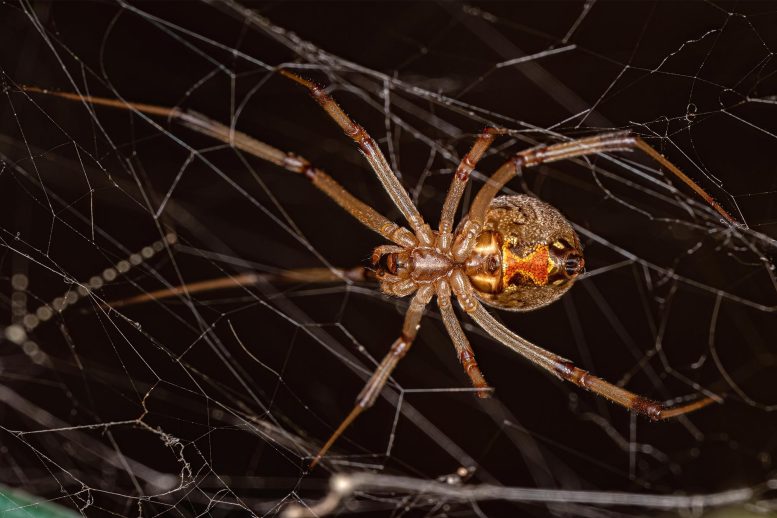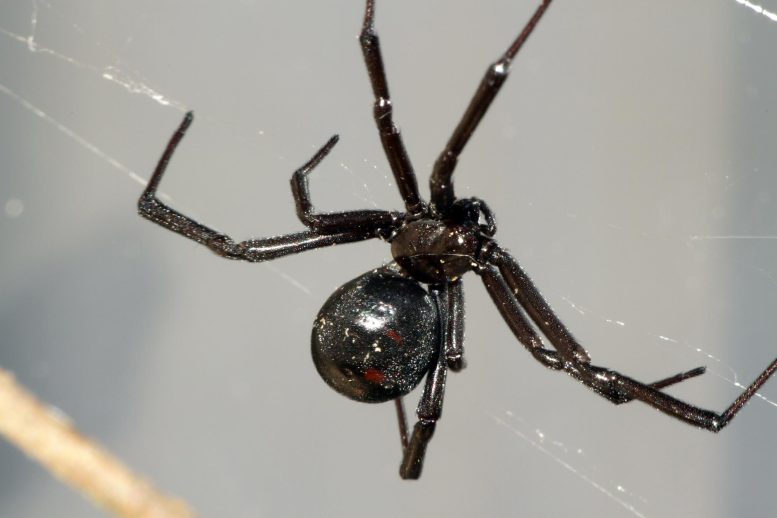
New study shows brown widow spiders actively seek and kill nearby black widows.
Black widow spiders have earned a fearsome reputation for their venomous bite. But in parts of the southern United States these spiders have much to fear themselves—from spider relatives who really don’t like their company.
In the past couple decades, researchers have noticed black widow spiders commonly being displaced by the brown widow, a fellow species in the same genus, Latrodectus. But new research suggests this isn’t a just simple case of one species winning the competition for food or habitat. Instead, a study shows brown widow spiders have a striking propensity to seek out and kill nearby black widows.
In experiments pairing brown widow spiders in container habitats with related cobweb spider species, the brown widows were 6.6 times more likely to kill southern black widows than other related species. The findings of the study, conducted by researchers at the University of South Florida (USF), are reported in an article to be published today (March 13, 2023) in the Annals of the Entomological Society of America.

“We have established brown widow behavior as being highly aggressive towards the southern black widows, yet much more tolerant of other spiders within the same family,” says Louis Coticchio, who led the study as part of his undergraduate research at USF.
Brown widow spiders (Latrodectus geometricus) are believed to be native to Africa but have been introduced on all continents but Antarctica. Black widow spiders are native to North America and comprise two closely related species, the western black widow (Latrodectus hesperus) and the southern black widow (Latrodectus mactans).
What Drives Brown Widow Spiders’ Displacement of Black Widows?
Coticchio spent the first part of his career as a zookeeper specializing in venomous animals in California and returned to Florida to earn a degree in biology, channeling a passion for spiders into his research projects. In collecting wild spiders in Florida, he says he noticed brown widows displacing black widows but not other related species. This got him wondering.
“I had a sneaking suspicion that Florida in particular provided plenty of food and habitat for both the brown and black widow, and that there was possibly some other area such as behavioral differences that were playing a role,” he says. “My observations in the field showed that brown widows appeared to be much more tolerant of other species outside of their genus, and so if resources were the main factor, then we should have seen the same behavior with other spiders competing for the same resources, but that did not seem to be that case.”

Coticchio partnered with advisor Deby Cassill, Ph.D., associate professor in the Department of Integrative Biology at USF. Along with spider expert Richard Vetter of the University of California, Riverside, they devised a three-part study to explore the potential drivers of brown widows displacing black widows.
One element of their study applied mathematical modeling to the risk factors to survival that brown and black widow spiders face, which showed both species are far more likely to die by predation than by starvation. In other words, “competition for scarce resources is not a significant cause of mortality among spiderlings for either species,” the researchers say.
They also compared rates of growth and fertility between brown and black widows, finding that sub-adult brown widow females were 9.5 percent larger than black widows, and adult female brown widows reached reproductive maturity 16 percent sooner. While adult male brown widows were 25 percent smaller than adult male black widows, they reached reproductive maturity 21 percent sooner. Meanwhile, brown widow females were about twice as fertile as black widows, with brown widows often producing multiple egg sacs at a time versus black widows producing just one.
Placing brown widows in proximity with black widows and other spider species, however, showed the clearest results. Sub-adult brown widow females simply cohabitated with red house spider (Nesticodes rufipes) females in 50 percent of pairings and were killed and consumed by the red house spiders in 40 percent. Brown widows cohabitated with triangulate cobweb spiders (Steatoda triangulosa) in 80 percent of pairings and were killed in just 10 percent. But when sub-adult brown and black widow females were paired, the brown widows killed and consumed the black widows in 80 percent of pairings. In pairings of adults, black widows were killed in 40 percent of trials, while they defensively killed brown widows in 30 percent of trials and cohabitated in the remaining 30 percent.
Throughout the experiments, brown widow spiders regularly ventured into black widow webs, the researchers say. Red house spiders and triangulate cobweb spiders also showed such “bold” behavior, but black widows were never observed as aggressors.
Surprising Behavior and New Questions Raised
“We didn’t expect to find such a dramatic and consistent difference in the personalities of the brown widow and the black widow,” Cassill says. “Brown widows are boldly aggressive and will immediately investigate a neighbor and attack if there is no resistance from the neighbor. For two bold spiders, the initial attack is often resolved by both individuals going to separate corners and eventually being OK with having a nearby neighbor. The black widows are extremely shy, counterattacking only to defend themselves against an aggressive spider.”
The characterization of brown widow spiders as “aggressive,” however, is a relative term, reflecting their stance toward black widow spiders, but not toward humans. While widow spiders are “synanthropic” (i.e., commonly found around human-made structures, such as barns, garages, and sheds), they “are very shy when harassed by humans or larger animals that are not considered prey,” Coticchio says. “They will run or roll up into a ball and play dead when being attacked or harassed by most other animals outside of their prey range.” Brown widow venom causes less severe reactions to humans than black widows, and bites to people are very rare.
Brown widow spiders’ evident aggression toward black widows raises many questions, perhaps first and foremost: Why? What drives such behavior toward a closely related species? The researchers note that invasive species typically outcompete natives through advantages in factors such as fertility, growth, dispersal, or defenses against predators. Direct predation by an invasive species on its native relative, across the animal kingdom, is rare.
“One question I would love to answer is how brown widows interact with other species of spiders, more specifically black widows in Africa, where brown widows are believed to have originated,” Coticchio says. “I would love to see if their behavior and displacement of black widows is something that they have adapted here in North America, or if this behavior is something they exhibit naturally even in areas where they have coevolved with black widows for much longer periods of time.”
Reference: “Predation by the Introduced Brown Widow Spider (Araneae: Theridiidae) May Explain Local Extinctions of Native Black Widows in Urban Habitats” by Louis A Coticchio, Richard Vetter and Deby L Cassill, 13 March 2023, Annals of the Entomological Society of America.
DOI: 10.1093/aesa/saad003
Never miss a breakthrough: Join the SciTechDaily newsletter.
2 Comments
I haven’t done any research on this question except having done some when I had a bit of an infestation at my home in Florida. My note is that male black widows are brown and smaller than females. Would it be possible that the brown widows are confusing the blacks or vice versa and maybe the black’s guard is down thinking a mate is approaching? Some kind of mistaken identity?
Can you please upload the dorsal view image of this spider? As fast as possible!